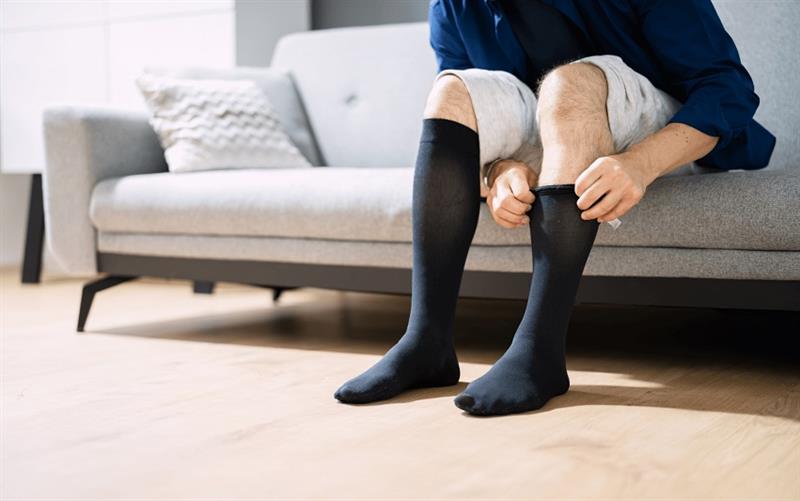
Compression stockings are a simple yet effective way to reduce the risk of DVT during flights. By improving blood circulation and preventing swelling, they can make your journey more comfortable and safer. When preparing for your next trip, consider investing in a good pair of compression stockings and follow the tips mentioned above to ensure a healthy and enjoyable flight experience.
Compression stockings are a valuable tool for airline passengers, offering multiple health and comfort benefits. From improving blood circulation to preventing DVT and reducing swelling, they can make a significant difference in how you feel during and after your flight. Consider investing in a good pair of compression stockings for your next trip to ensure a safer, more comfortable journey.
Compression stockings are specially designed to apply gentle pressure to your legs, promoting blood flow from your lower limbs back to your heart. They are typically tighter around the ankles and gradually loosen as they go up the leg. This gradient pressure helps to prevent blood from pooling and clotting in the veins.
Understanding Deep Vein Thrombosis
Deep Vein Thrombosis occurs when blood clots form in the deep veins of the legs. The main factors contributing to DVT during flights include prolonged immobility, dehydration, and the lower air pressure in the cabin. Symptoms of DVT can include swelling, pain, and redness in the affected leg, but sometimes there are no noticeable symptoms at all.
Benefits of Compression Stockings for Airline Passengers
Compression stockings offer numerous benefits to airline passengers, especially those on long-haul flights. Here’s a detailed look at how they can enhance your travel experience:
1. Improved Blood Circulation
Compression stockings are designed to apply pressure to your legs, with the highest pressure at the ankles and gradually decreasing up the leg. This gradient pressure helps to:
- Enhance Blood Flow: The stockings assist in pushing blood back up towards the heart, countering the effects of gravity and prolonged sitting.
- Prevent Blood Pooling: By keeping the blood moving, they reduce the likelihood of blood pooling in the lower legs, which can lead to clot formation.
2. Reduced Swelling and Discomfort
Long periods of immobility during flights can cause fluid retention in the legs, leading to swelling (edema) and discomfort. Compression stockings help to:
- Minimize Swelling: The pressure exerted by the stockings prevents fluids from accumulating in the tissues, reducing swelling.
- Alleviate Discomfort: Reduced swelling means less tightness and pain in the legs, making your flight more comfortable.
3. Prevention of Deep Vein Thrombosis (DVT)
One of the most critical benefits of compression stockings is their role in preventing DVT. They achieve this by:
- Promoting Venous Return: By enhancing blood flow back to the heart, the risk of blood clot formation in the deep veins is significantly reduced.
- Evidence-Based Effectiveness: Studies have shown that airline passengers who wear compression stockings are less likely to develop DVT compared to those who do not.
4. Enhanced Comfort and Support
Modern compression stockings are designed with comfort in mind. They provide:
- Gentle, Consistent Pressure: The stockings offer a snug but comfortable fit, ensuring that the pressure is consistent throughout the journey.
- Support for Tired Legs: The added support can help prevent fatigue and aching in the legs, making long flights more bearable.
5. Discreet and Stylish Options
Gone are the days when compression stockings were bulky and unattractive. Today’s options include:
- Discreet Designs: Many compression stockings are designed to look like regular socks or hosiery, making them easy to wear without drawing attention.
- Variety of Styles: Available in different colors, lengths, and patterns, you can choose a pair that suits your style and wardrobe.
6. Additional Health Benefits
Beyond preventing DVT and reducing swelling, compression stockings can also:
- Aid in Recovery: For those recovering from surgery or with certain medical conditions, compression stockings can help manage symptoms and support recovery.
- Prevent Varicose Veins: By promoting better blood flow, compression stockings can also reduce the risk of developing varicose veins or manage existing ones.
7. Enhanced Comfort During Long Flights
- Reduced Fatigue: By improving blood flow, compression stockings can reduce the feeling of heaviness and fatigue in your legs, making long flights more comfortable.
- Support for Muscles: The gentle pressure supports the calf muscles, reducing muscle fatigue and soreness, especially useful for passengers who are prone to leg cramps.
8. Prevention of Varicose and Spider Veins
- Minimized Vein Distension: By promoting blood flow, compression stockings help prevent the distension of veins, reducing the risk of developing varicose and spider veins.
- Improved Vein Health: Regular use of compression stockings can improve the overall health of your veins, making them less likely to become varicose.
9. Temperature Regulation
- Insulation: Compression stockings can provide an additional layer of insulation, keeping your legs warm in the often chilly cabin environment.
- Breathability: Advanced materials used in compression stockings help regulate temperature and moisture, keeping your legs cool and dry.
10. Travel-Specific Designs
- Convenience: Some compression stockings are designed with travel in mind, featuring easy-on/easy-off designs, making them convenient to use even in tight airplane seats.
- Stylish Options: Modern designs and colors ensure you can wear them discreetly and stylishly, whether in casual or business attire.